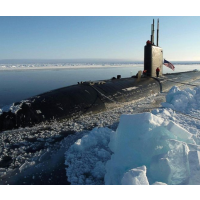As Arctic Ice Melts, U.S. Navy Expands its Presence
 US Navy attack submarine at the North Pole (photo: Kevin Elliott, US Navy)
US Navy attack submarine at the North Pole (photo: Kevin Elliott, US Navy)
With global warming causing a dramatic and rapid reduction of ice in the Arctic Ocean, the U.S. Navy is preparing for a new era of seafaring around the North Pole.
Changes are happening so fast up north that the Navy felt it necessary to update its Arctic plan, which was created only five years ago. But new scientific calculations showed commercial shipping lanes may open where none existed before in just another six years.
The Navy’s latest Task Force Climate Change report (pdf) says the Bering Strait will become ice-free for more than five months at a time by 2020, and that deeper Transpolar routes could be available for 45 days by 2025.
“The Arctic is all about operating forward and being ready. We don’t think we’re going to have to do war-fighting up there, but we have to be ready,” Rear Admiral Jonathan White, the Navy’s top oceanographer and navigator, and director of the Navy’s climate change task force, told Reuters.
Naval readiness means doing more research on climate change impacts in the Arctic, and figuring out how and where to base and operate ships and planes for missions in this region, among other concerns.
The Navy is also planning submarine exercises for the Arctic, and it intends to work with Norway and Russia on joint training exercises.
Russia is among the many countries with eyes on natural resources that could become exploitable once the ice sheets thin, if not disappear for long stretches. The naval report says a less frozen Arctic could yield $1 trillion in oil, gas and minerals for companies and countries to pursue.
But less sea ice would not necessarily mean smooth sailing in the Arctic, which would still be a treacherous environment to work in.
“If we do start to see a rush, and people try to get up there too fast, we run the risk of catastrophes,” White said, who hopes companies will be slow and careful in entering the region. “Search and rescue in the cold ice-covered water of the Arctic is not somewhere we want to go.”
-Noel Brinkerhoff
To Learn More:
Faced with Declining Ice Cover, U.S. Navy Eyes Greater Presence in Arctic (Reuters)
U.S. Navy Arctic Roadmap 2014-2030 (Navy Task Force Climate Change) (pdf)
As Arctic Ice Melts, U.S. Competes for Oil, Gold and other Resources (by David Wallechinsky and Noel Brinkerhoff, AllGov)
U.S. Navy Prepares for Militarization of the Arctic (by Noel Brinkerhoff, AllGov)
- Top Stories
- Unusual News
- Where is the Money Going?
- Controversies
- U.S. and the World
- Appointments and Resignations
- Latest News
- Trump to Stop Deportations If…
- Trump Denounces World Series
- What If China Invaded the United States?
- Donald Trump Has a Mental Health Problem and It Has a Name
- Trump Goes on Renaming Frenzy






Comments